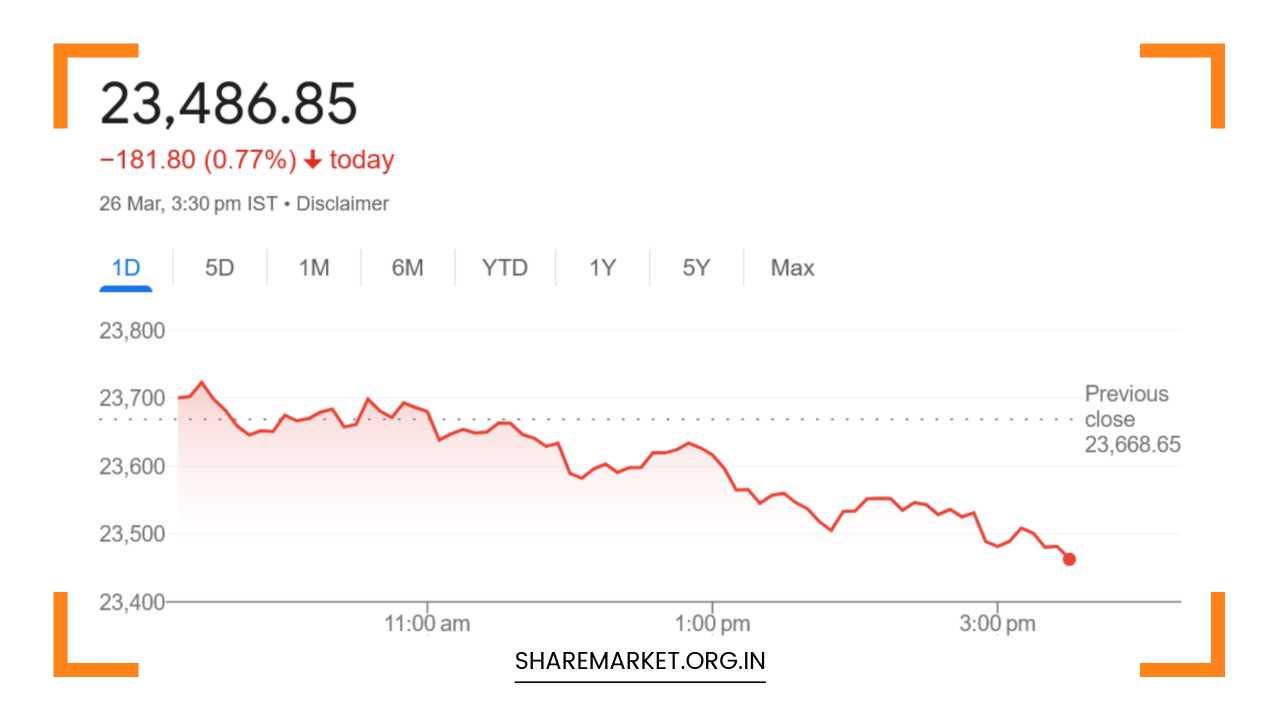Sensex Down 728 Points, Nifty at 23,486; Tomorrow Nifty Prediction

Tomorrow Nifty Prediction
Sensex and Nifty Close Lower: Market Analysis and Predictions for March 27
On March 26, the Indian stock market witnessed a significant pullback, with both the Sensex and Nifty closing lower, following seven days of consecutive gains.
Despite the positive developments observed throughout March, such as the weakening dollar index, strengthening rupee, and reduced FII (Foreign Institutional Investor) withdrawals, the market faced mounting pressures as it approached the end of the month.
In particular, uncertainty surrounding tariff policies and their potential impact on the global and domestic economy has been a source of concern for investors.
Market Overview and Sectoral Performance:
The stock market faced downward pressure as investors started to show caution ahead of the March expiry, with sectoral indices across the Bombay Stock Exchange (BSE) registering a decline.
While the market had seen a steady rally over the past week, the end-of-month profit-taking and the uncertainty in the global trade environment caused a reversal in the trend.
On the closing day, the Nifty ended 182 points lower, closing at 23,487, while the Sensex fell 729 points to end at 77,289.
The Nifty Bank index, which has been a critical gauge of financial sector performance, saw a sharp drop of 399 points, settling at 51,209. Midcap stocks also came under pressure, with the BSE Midcap index losing 324 points to close at 51,656.
This downward trend was broad-based, affecting all key sector indices. Major selling pressure was seen in midcap and smallcap stocks, with investors choosing to book profits after a period of sustained growth.
Notably, sectors such as Public Sector Enterprises (PSE), oil and gas, real estate, pharmaceuticals, Information Technology (IT), and energy witnessed significant declines.
The IT sector, which had seen a robust recovery over the past few months, ended in the red, highlighting the market’s vulnerability to broader uncertainties.
Out of the 50 stocks in the Nifty index, 41 closed in the negative, signaling widespread weakness across various sectors.
Similarly, 26 out of the 30 Sensex stocks saw declines, reinforcing the overall bearish sentiment in the market. Among the most actively traded stocks on the National Stock Exchange (NSE) were Zomato, Mazagon Dock, IndusInd Bank, HDFC Bank, and NCC.
These stocks were caught in the wave of selling, with investors pulling back from growth-oriented stocks amid market volatility.
In contrast, the BSE Midcap index managed to rise by 0.4%, and the BSE Smallcap index ended flat, suggesting that smaller stocks are currently experiencing mixed performance compared to their larger counterparts.
What’s Driving the Market Correction?
The correction observed in the market can be attributed to several key factors. First, the market has experienced a strong rally in recent weeks, leading to an overbought condition.
After seven consecutive days of gains, it is not uncommon for markets to undergo a period of consolidation or correction, as traders and investors look to lock in profits before potential risks materialize.
This natural pullback is further compounded by the approaching expiry of derivative contracts for the month of March, which often leads to increased volatility as traders adjust their positions.
Second, the uncertainty surrounding global trade policies, particularly with respect to tariffs, remains a major concern for investors.
While the weakening of the US dollar and strengthening of the Indian rupee are positive developments, tariff-related tensions, especially those arising from the US, continue to loom large over global markets.
The unpredictability of tariff timelines and their potential impact on industries such as manufacturing, technology, and agriculture are weighing heavily on investor sentiment.
In the Indian context, investors are particularly concerned about how these uncertainties could affect exports and foreign investment flows.
Another factor contributing to market nervousness is the upcoming Reserve Bank of India (RBI) policy decision scheduled for April 2.
The central bank’s stance on interest rates and its commentary on inflation and economic growth will play a crucial role in determining the future direction of the market.
Should the RBI adopt a more cautious or dovish approach, it could create additional headwinds for equities, particularly for sectors sensitive to interest rate changes, such as banking and real estate.
Expert Opinions:
Aishwarya Dadhich, the Founder and Chief Investment Officer (CIO) of Fident Asset Management, provided valuable insights into the current market dynamics.
Speaking to Moneycontrol, Dadhich explained that the market’s recent consolidation is primarily driven by domestic selling pressure, end-of-month portfolio rebalancing, and the looming uncertainties surrounding tariff policies and the RBI’s upcoming policy.
According to Dadhich, the strong rally observed over the past seven days had led the market to become overbought, making the current correction a natural market reaction.
Dadhich pointed out that while several positive developments have unfolded since the beginning of March, including a weaker dollar index, a stronger rupee, and a reduction in FII withdrawals, the uncertainty over tariff policies remains a key risk for the market.
He emphasized that although tariff-related fears are currently troubling investors, he believes that the “tariff tantrum” from former US President Donald Trump is unlikely to have any significant long-term impact on India’s economy or markets.
Anand James, the chief market strategist at Geojit Financial Services, also weighed in on the market’s direction.
According to James, the Nifty found support at the 23,600 level during the previous session, which helped arrest the sharp decline seen earlier in the day.
However, James warned that if the Nifty were to break below 23,600, it could potentially fall further to the 23,300 level.
On the flip side, if the index manages to bounce back above the 23,700-23,760 range, it could signal the resumption of upward momentum, providing traders with a possible opportunity for short-term gains.
Market Prediction for March 27:
Looking ahead, the market may continue to experience volatility as it navigates through the uncertainties of March expiry, upcoming tariff developments, and the RBI policy.
The level of 23,600 remains a key support for Nifty, and a break below this level could trigger further declines, with 23,300 seen as the next critical support zone.
On the other hand, if the Nifty can recover and move above 23,700-23,760, it could reignite buying interest and lead to a potential rally.
Investors should remain cautious and closely monitor developments surrounding the tariff timeline and RBI policy.
Given the mixed signals in global and domestic markets, it is advisable for investors to adopt a more prudent approach and consider diversifying their portfolios to manage risk effectively.
In conclusion, while the market has faced a temporary setback, the underlying fundamentals remain intact.
The positive macroeconomic factors, including a stronger rupee and reduced FII withdrawals, should support the market over the medium to long term.
However, investors must stay alert to any major developments that could impact global trade dynamics and influence investor sentiment in the coming weeks.

















